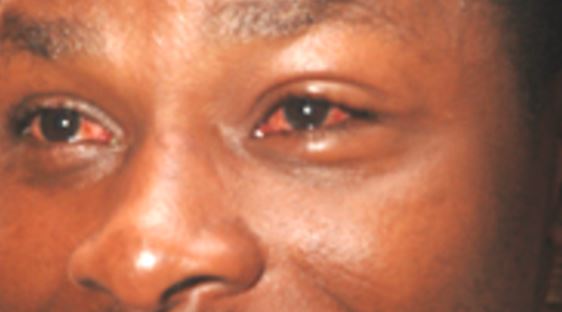Explainer: Causes and symptoms of red eye disease affecting Coast residents

County health officials from the Coast region have urged residents to be cautious after a notable number of learners sought medical care for eye infections at various health facilities.
The Coast region is on high alert after health officials in Kilifi and Mombasa counties warned of the outbreak of 'red eye' disease suspected to have originated from Tanzania.
The officials urged the residents to be cautious after a notable number of learners at the Coast sought medical care for eye infections at various health facilities.
More To Read
- Surviving the next pandemic could depend on where you live
- WHO urges countries to protect health budgets amid aid reductions
- Northern Kenya PWDs chairperson sounds alarm over lack of autism support
- Turkana moves to safeguard health with bold One Health Bill
- When fever leads to seizures: What every parent needs to know
- Mpox cases in Africa surpass 190,000, deaths near 2,000: Africa CDC
Kilifi's Department of Health Services on Tuesday, without giving an exact number, informed the public of an increased number of infections in the region.
What is the conjunctivitis ‘red eye’ disease?
The American Academy of Ophatomology, the world's largest association of eye physicians and surgeons, describes conjunctivitis—often called “red or pink eye”—as the inflammation of the conjunctiva from infection or allergies.
It is commonly referred to as red eye disease because it can cause the white of the eye to take on a pink or red colour.
According to the UK's National Health Service (NHS), conjunctivitis usually affects both eyes, causing redness, burning sensations, grittiness, pus that adheres to lashes, itching, or excessive tearing.
Its symptoms can vary but typically they include redness or swelling of the white of the eye.
Centres for Disease Control and Prevention says the most common causes of conjunctivitis are viruses, bacteria and allergens.
Other causes include; chemicals, contact lens wear, foreign bodies in the eye (like a loose eyelash), indoor and outdoor air pollution caused, for example, by smoke, dust, or fumes, fungi, amoeba and parasites.
CDC notes that it can be difficult to determine the exact cause of conjunctivitis because some symptoms may be the same no matter the cause.
The following are some of the symptoms of viral, bacterial and allergic conjunctivitis, according to the CDC.
Viral conjunctivitis:
Can occur with symptoms of a cold, flu, or other respiratory infection.
Usually begins in one eye and may spread to the other eye within days.
Discharge from the eye is usually watery rather than thick.
Bacterial conjunctivitis:
More commonly associated with discharge (pus), which can lead to eyelids sticking together.
Sometimes occurs with an ear infection.
Allergic conjunctivitis:
Usually occurs in both eyes, which may become watery, puffy, itchy or red.
Blurred vision or sensitivity to light.
General symptoms of conjunctivitis
Pink or red colour in the white part of the eye(s).
Swelling of the conjunctiva (the thin layer that lines the white part of the eye and the inside of the eyelid).
Increased tear production.
Feeling like a foreign body is in the eye(s) or an urge to rub the eye(s).
Itching, irritation, and/or burning.
Discharge from the eyes (pus or mucus).
Crusting of eyelids or lashes, especially in the morning.
Contact lenses that feel uncomfortable and/or do not stay in place on the eye.
How to prevent the spread of conjunctivitis
Wash your hands often with soap and warm water or use an alcohol-based hand sanitiser.
Avoid touching or rubbing your eyes to avoid infecting the other eye.
With clean hands, severally wash any discharge from around your eye(s) with a clean and wet cloth.
Do not use the same eye drop dispenser/bottle for your infected and non-infected eyes.
Wash pillowcases, sheets, washcloths, and towels often in hot water and detergent.
Stop wearing contact lenses until your eye doctor says it’s okay to start wearing them again.
Clean eyeglasses, being careful not to contaminate items (like hand towels) that might be shared by other people.
Clean, store, and replace your contact lenses as instructed by your eye doctor.
Do not share personal items, such as pillows, washcloths, towels, eye drops, eye or face makeup, makeup brushes, contact lenses, contact lens storage cases, or eyeglasses.
Do not use swimming pools.
Vaccines
The CDC notes that there is no vaccine that prevents all types of conjunctivitis.
“However, there are vaccines to protect against some viral and bacterial diseases that are associated with conjunctivitis: Rubella, Measles, Chickenpox, Shingles, Pneumococcal and Haemophilus influenzae type b (Hib).
Doctors from Columbia University Irving Medical Center Doctors say acute conjunctivitis usually goes away in a few days, while chronic conjunctivitis can last much longer or come back again and again.
"Conjunctivitis usually does not cause permanent vision problems. However, it can cause damage in rare cases if symptoms are severe and are not properly treated," they say.
Top Stories Today











































